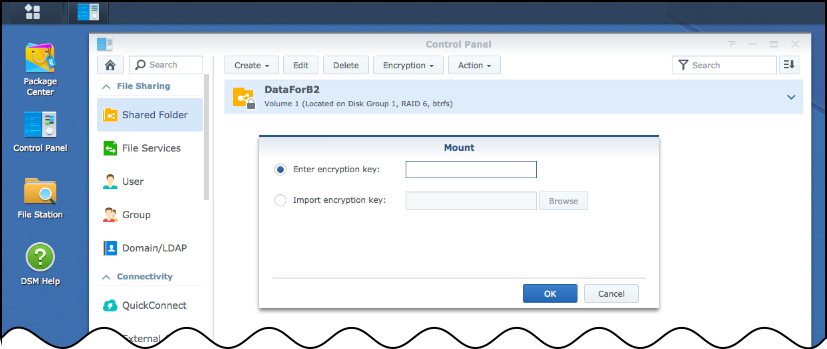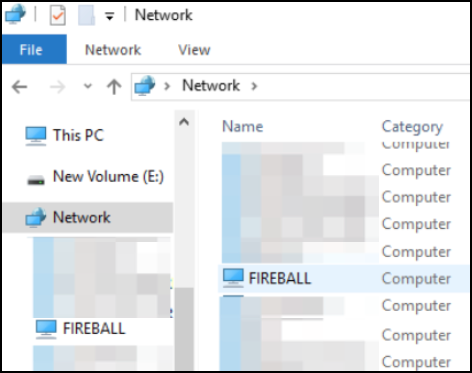- Print
- DarkLight
Upload Files to a Synology NAS Using the Backblaze Fireball Program
- Print
- DarkLight
The Backblaze Fireball program is a way to import data into Backblaze B2 Cloud Storage.
The program consists of a Synology network attached storage (NAS) device with a 10GigE add-in card that can be filled in a few days. Click here for more information.
Seeding data for use with a third-party backup or archiving tool may require additional steps or preparation.
In many cases, you must load the data onto the Backblaze Fireball with the integration partner’s tools.
Some software may have additional requirements. Please check with our integration partner if there is any uncertainty.
Set Up the Synology NAS
Although the illustration shows only two drive bays, you must insert all eight of the included drives into the Synology NAS.
.png)
- Unpack the Synology NAS.
- Place the disks that are installed in trays into the Synology NAS in any order.
Connect the NAS to the Network
The Backblaze Fireball NAS must be connected directly to the network. At a small office, this might be a network switch or router.
The NAS cannot be directly connected to a computer. The NAS supports only a direct network connection using either the 1GigE or 10GigE ports.
You should connect the NAS to the data source over a wired connection. Wireless (Wi-Fi) connections have limited bandwidth, and data transfer will take much longer than with a direct connection. Also, network traffic to other devices on the wireless network can suffer performance loss when competing for bandwidth with the NAS.
- Connect the power cable to the NAS.
- Plug in the NAS.
- Turn on the NAS with the power button.
Obtain your Fireball Password and Encryption Key
The username for all Backblaze Fireballs is always backblaze.
- Sign in to your Backblaze account to which the data is to be transferred.
- In the left navigation menu under B2 Cloud Storage, click Fireball.
- Click the information icon that is associated with your Backblaze Fireball order, and copy your encryption key.
Enter Your Password and Encryption Key
To protect customer data, all of the data that is sent to Backblaze on the NAS is encrypted.
The encryption key is kept only in volatile storage (in memory) on the Backblaze Fireball. Every time you power down or reset the NAS, you must re-enter the configuration information (the encryption key). Scan your local network for all Synology devices.

- Go to find.synology.com.
- Double-click the Fireball in the list.
Your browser should directly connect to the Fireball's web page. If no Fireballs are detected, check your network connection with the Fireball and ensure that it is on the same subnet as your computer. - Sign in using
backblazeas the username, and enter the password that you obtained from your Backblaze B2 account. - Select Control Panel, and select Shared Folder.
- Click DataForB2, and click Encryption.
- Select Mount.
- Enter the encryption key that you obtained from your Backblaze B2 account.
- Close the window.
Locate the Fireball on the Local Network (Windows)

- Find the Fireball in the network listing.
- If the device is missing from this list, open Windows Explorer and enter
\\fireballinto your local network area.
A prompt for the Fireball’s name and password appears.
Locate the Fireball on the Local Network (Mac)

- Find the listing for the Fireball in Finder.
- If the listing is not present, add it manually.
- In Finder, click Go→ Connect to Server.
- Enter
fireball.
Mount the Share
- Mount the share DataForB2.
- Enter the username and password that was provided by Backblaze.
Copy Your Data to the Fireball NAS
Copy your data to the Fireball NAS.
Return NAS Settings to Default
If you made changes to the NAS device specific to your environment, such as network settings, set them back to the default settings. This makes uploading the data easier when Backblaze receives the unit. Shut down the NAS from the Synology web interface.

Uninstall the Hard Drives and Return the Fireball
- To ensure the integrity of the NAS and the hard drives, uninstall the hard drives from the NAS trays.
- Repack the hard drives and the NAS.
- Return all of the items back to Backblaze:
Backblaze Fireball Return
C/O Sungard
11085 Sun Center Dr
Rancho Cordova, CA 95670
When Backblaze receives the hard drives and the Fireball, the NAS is connected to an internal network and the file upload is completed at network traffic speeds.
Restrictions
The following restrictions apply to files that are sent to Backblaze B2 using a Fireball.
Special Characters
The folder or file path must not contain any of the following characters.
| Character | Name | ASCII | Unicode |
|---|---|---|---|
| * | Asterisk | 43 | U+002A |
| : | Colon | 58 | U+003A |
| ? | Question Mark | 63 | U+003F |
| \ | Backslash | 92 | U+005C |
| / | Slash (Solidus) | 47 | U+002F |
| < | Less-than Sign | 60 | U+002C |
| " | Quotation Mark | 34 | U+0022 |
| > | Greater-than Sign | 62 | U+003E |
| | | Vertical Bar | 124 | U+007C |
File and Folder Names
Files and folder names must not contain any of the following items.
| Name | Description |
|---|---|
.DS_Store | macOS special files and folders |
desktop.ini | Windows special files and folders |
.SynologyWorkingDirectory @eaDir .synoppsdb | Synology special files and folders |
.gdoc | Google docs special files and folders |
Other Restrictions
- The folder or file path is longer than 1000 (one thousand) characters.
- The file name is longer than 143 (one hundred and forty three) characters.
- Folder names must not end with a period or full stop ( . ).
- The file is a symlink.
- macOS extended attributes like Finder metadata and Resource Forks will not be synced to Backblaze B2.
- Files that point to online resources may not upload as expected. For example, when Google Docs syncs a file to the desktop, the file created locally is not a working copy of the document but a symbolic link (symlink) to the cloud version. Copying this kind of file does not create a backup of the actual file, just a copy of the link.
